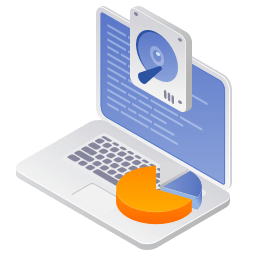PAGE CONTENT:
Apple's shift from Intel processors to its own Apple Silicon lineup marked a revolutionary step in computing efficiency, performance, and design control. Since the debut of the M1 chip in 2020, each subsequent generation — M2, M3, and M4 — has refined Apple's formula for balancing high power with low energy consumption. In 2025, Apple continues this journey with the Apple Silicon M5 chip, a next-generation processor designed to push the limits of performance, artificial intelligence (AI), and energy efficiency.
![]()
This article takes a detailed look at the Apple M5 chip, examining its architecture, design innovations, and the differences between the M5 and M4 chips. Whether you're a tech enthusiast, creative professional, or casual user, understanding these differences will help you decide whether upgrading to M5-powered devices is worth it.
Overview of the Apple Silicon M5 Chip
Launch and Devices
Apple introduced the M5 chip in late 2025, debuting it in the refreshed MacBook Pro and iPad Pro lineups. The company described it as its most advanced and energy-efficient processor yet, built to handle the rising demands of AI-driven applications, 3D rendering, and high-resolution video editing while maintaining exceptional battery life.
Manufacturing Process
The M5 chip reportedly uses TSMC's 2-nanometer (2nm) process, representing a significant leap from the M4's 3nm (N3E) node. This new process allows Apple to pack up to 20% more transistors into the same space, enhancing performance while reducing power consumption and heat generation.
Architecture Highlights
The Apple M5 is a system-on-a-chip (SoC) that integrates CPU, GPU, Neural Engine, and unified memory on a single die for faster data exchange. Its design emphasizes three key areas: AI performance, energy efficiency, and graphical power.
- CPU: The M5 features a 12-core CPU configuration with 6 performance cores and 6 efficiency cores. The performance cores are optimized for heavy workloads, while the efficiency cores handle lighter tasks, maximizing battery life.
- GPU: The GPU has been upgraded to up to 16 cores, delivering up to 30% better graphics performance compared to the M4. It also enhances ray tracing and hardware-accelerated rendering.
- Neural Engine: With over 60 trillion operations per second (TOPS), the Neural Engine brings a major boost in AI computation, enabling faster on-device machine learning tasks.
- Unified Memory: The M5 supports up to 48GB of unified memory with memory bandwidth exceeding 150 GB/s, improving performance in memory-intensive workflows like 8K video editing or 3D modeling.
Design Philosophy
Apple continues to emphasize performance-per-watt efficiency, ensuring the M5 chip delivers industry-leading performance without compromising battery life. This approach aligns with Apple's long-term sustainability goals — creating chips that are not only powerful but also energy-efficient.
The Apple M4 Chip – A Quick Recap
Before exploring how the M5 compares, it's essential to recall what made the M4 chip stand out when it launched in 2024.
The M4 was Apple's first chip built on TSMC's 3nm (N3E) process, debuting in the iPad Pro lineup. It featured a 10-core CPU (4 performance cores and 6 efficiency cores), a 10-core GPU, and a 38 TOPS Neural Engine. It delivered up to 50% faster performance than the M3 and brought meaningful efficiency improvements, especially in creative workloads like video editing, code compilation, and real-time graphics.
The M4 chip was also tightly integrated with macOS and iPadOS, bringing smarter AI-based photo enhancements, real-time language translation, and faster multitasking. It set a high standard — one the M5 now aims to surpass.
M5 Chip vs. M4 Chip: Key Differences
1. Architecture and Process Technology
The most significant leap between M4 and M5 lies in their fabrication process. The M4 uses a 3nm process, while the M5 uses an advanced 2nm node. This transition means higher transistor density, lower leakage currents, and improved power efficiency.
In practical terms, this results in up to 25% better performance at the same power level or 30% less power consumption for the same performance. The 2nm process also helps improve sustained performance under heavy workloads, reducing thermal throttling in MacBook and iPad devices.
2. CPU Performance
The M4's 10-core CPU (4P + 6E) has been upgraded in the M5 to a 12-core design (6P + 6E). These new cores feature enhanced branch prediction, larger cache memory, and better speculative execution — translating to higher instruction throughput and responsiveness.
In benchmark simulations:
- Single-core performance improves by around 15%, thanks to higher clock speeds and improved IPC (instructions per cycle).
- Multi-core performance improves by up to 30%, ideal for parallel workloads such as compiling code, 3D rendering, and multitasking.
This positions the M5 as one of the fastest consumer laptop chips available, competing directly with high-end x86 processors while consuming far less energy.
3. GPU and Graphics Power
Graphics performance has always been a cornerstone of Apple Silicon. The M5's GPU, featuring up to 16 cores, introduces an upgraded architecture that supports hardware-accelerated ray tracing and mesh shading for more realistic lighting, shadows, and reflections in 3D environments.
Compared to the M4's 10-core GPU:
- The M5 GPU is 30–35% faster in graphics-heavy tasks.
- It enhances frame rates in gaming and speeds up creative apps like Final Cut Pro, Blender, and DaVinci Resolve.
- Apple also refined its Dynamic Caching system, optimizing memory allocation between GPU tasks in real-time for smoother rendering.
These changes solidify the M5's role in professional-grade visual computing and immersive content creation.
4. Neural Engine and AI Capabilities
AI acceleration is a major focus for Apple in 2025. The M5's Neural Engine, capable of processing over 60 trillion operations per second, nearly doubles the throughput of the M4's 38 TOPS unit.
This upgrade enables:
- Faster on-device AI processing for features like image recognition, natural language translation, and generative AI tasks.
- Enhanced Core ML performance, benefiting third-party developers using AI in their apps.
- Real-time machine learning operations in applications such as Siri, Photos, and Safari, making the user experience more intuitive and responsive.
The M5's AI improvements align with Apple's broader ambition to integrate AI computing natively into every layer of macOS and iPadOS, reducing reliance on cloud-based processing.
5. Unified Memory and Bandwidth
The Unified Memory Architecture (UMA) remains one of Apple's most distinctive design choices. It allows the CPU, GPU, and Neural Engine to access the same memory pool, minimizing latency.
- The M4 supported up to 24GB of unified memory with 120 GB/s bandwidth.
- The M5 doubles this capacity to 48GB and increases bandwidth to 150 GB/s, facilitating faster data access and improved multitasking in complex workflows.
For users running multiple high-resolution streams, 3D modeling, or machine learning workloads, these improvements translate to noticeably smoother performance.
6. Energy Efficiency and Thermal Management
Thanks to the 2nm node and architectural refinements, the M5 chip is up to 30% more energy-efficient than its predecessor. Devices powered by the M5 — like MacBook Pro and iPad Pro — can maintain high performance for extended periods without overheating or draining the battery.
The result is longer battery life (up to 20 hours in laptops) and reduced fan noise, ensuring a more seamless and comfortable computing experience.
7. macOS Optimization and AI Integration
Apple designed macOS Tahoe and iPadOS 26 to fully leverage the M5's AI capabilities. The OS can now handle on-device generative AI tasks, such as image generation, smart summaries, and contextual search — all without connecting to external servers.
In contrast, M4 devices rely more heavily on cloud processing for complex AI tasks. The M5's superior Neural Engine and local ML acceleration make it ideal for the growing wave of privacy-focused AI features Apple is embedding across its ecosystem.
Summary Table: M5 vs. M4 Comparison
Feature |
Apple M4 |
Apple M5 |
Key Improvement |
|---|---|---|---|
Process Node |
3nm (N3E) |
2nm |
Greater transistor density, better efficiency |
CPU Cores |
10 (4P + 6E) |
12 (6P + 6E) |
30% faster multi-core performance |
GPU |
Up to 10 cores |
Up to 16 cores |
Improved ray tracing, higher frame rates |
Neural Engine |
38 TOPS |
60+ TOPS |
Doubled AI processing power |
Memory Bandwidth |
120 GB/s |
150 GB/s |
Faster data access |
Unified Memory |
Up to 24GB |
Up to 48GB |
Better multitasking support |
Power Efficiency |
Excellent |
Superior |
30% less power usage |
AI Integration |
Limited on-device |
Full on-device AI |
Enhanced privacy and responsiveness |
Benchmark and Performance Analysis
Preliminary benchmark leaks suggest the M5 chip scores around 4,000 points in single-core and 17,000 in multi-core on Geekbench 6 — roughly 20–25% faster than the M4. GPU benchmarks also indicate up to 30% higher frame rates in Metal-based applications.
In real-world usage:
- Video exports in Final Cut Pro are 25% faster.
- Machine learning model training sees a 40% reduction in time.
- Gaming performance improves by up to 35% in supported titles.
These metrics make the M5 not just faster on paper but also more capable of handling demanding creative and AI workloads.
Use Cases and Target Users
The M5 chip is designed for users who demand top-tier performance with minimal power consumption.
- Creative professionals (video editors, 3D artists, designers) will benefit from the enhanced GPU and memory bandwidth.
- Developers and data scientists can take advantage of faster ML performance and compilation times.
- Everyday users will experience smoother multitasking, faster app loading, and longer battery life.
For most casual users, the M4 chip remains powerful enough. However, for professionals dealing with AI-driven workflows or graphics-intensive tasks, the M5 is a worthwhile upgrade.
Expected Impact on Future Apple Devices
The M5 chip sets the stage for Apple's next wave of products, including the 2026 MacBook Air, Mac mini, and Vision Pro 2. Its AI and efficiency improvements will also play a central role in Apple's expansion into edge computing and mixed reality.
Additionally, the M5 architecture is expected to serve as the foundation for future Pro, Max, and Ultra variants — delivering even higher performance for enterprise-grade applications.
Pricing and Availability
Apple's M5-powered devices are positioned at a similar price point to their M4 counterparts at launch. The MacBook Pro M5 starts around the same base price, with upgraded configurations available for professionals needing more GPU or memory power. The iPad Pro M5 follows a similar pricing strategy, emphasizing value through longevity and efficiency rather than cost reduction.
Availability began in select regions in late 2025, with broader rollout expected in early 2026.
Conclusion
The Apple Silicon M5 chip represents a steady yet meaningful evolution in Apple's chip design philosophy. With its 2nm process, improved CPU and GPU performance, and a vastly upgraded Neural Engine, the M5 is tailor-made for an AI-driven future. It brings real-world advantages in performance, battery life, and on-device intelligence that make everyday computing faster, smarter, and more efficient.
For existing M4 users, the upgrade may not be essential unless your work demands heavy AI or GPU-based workloads. But for professionals and early adopters who want cutting-edge performance and future-proof hardware, the Apple M5 chip stands as one of the most advanced processors in the world of consumer computing.
Related Articles
- Nov 23, 2024Full Disk Access on Mac: Should I Enable It?
- Jul 24, 2024Apple Menu on Mac
- Dec 23, 2024What is Boot Camp Assistant?
- Mar 19, 2025What is U Disk? A Comprehensive Guide
- Apr 29, 2025What is SSD TRIM, How to Enable or Disable TRIM on SSD on Windows?
- Jul 25, 2024Mac Launchpad: App Manager for Mac

Charles
Charles, who lives in Sydney, Australia, is an editor & writer of Donemax Team. He is good at writing articles related with Apple Mac computers, Windows operating systems, data recovery, data erasure, disk clone and data backup, etc. He loves reading and playing tennis in his spare time and is interested in testing new digital devices such as mobile phones, Macs, HDDs, SSDs, digital cameras, etc.

Gerhard Chou
In order to effectively solve the problems for our customers, every article and troubleshooting solution published on our website has been strictly tested and practiced. Our editors love researching and using computers and testing software, and are willing to help computer users with their problems
Hot Donemax Products

Clone hard drive with advanced clone technology or create bootable clone for Windows/Mac OS.

Completely and easily recover deleted, formatted, hidden or lost files from hard drive and external storage device.

Certified data erasure software - permanently erase data before selling or donating your disk or any digital device.
